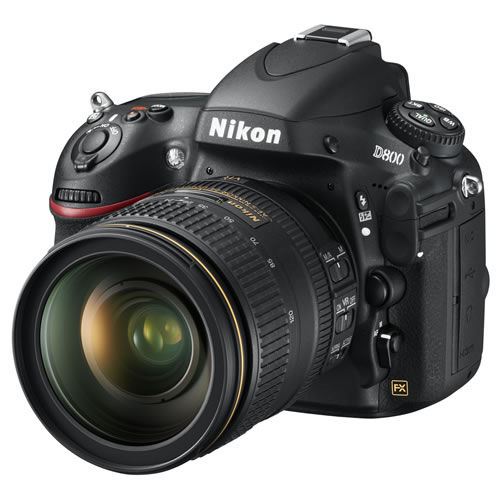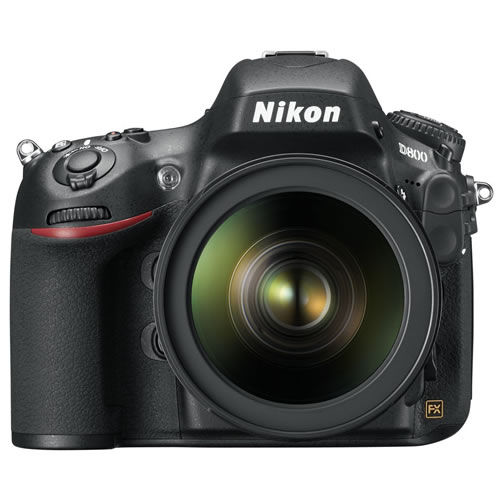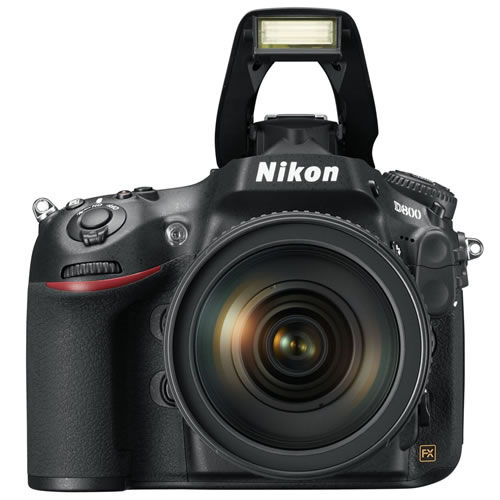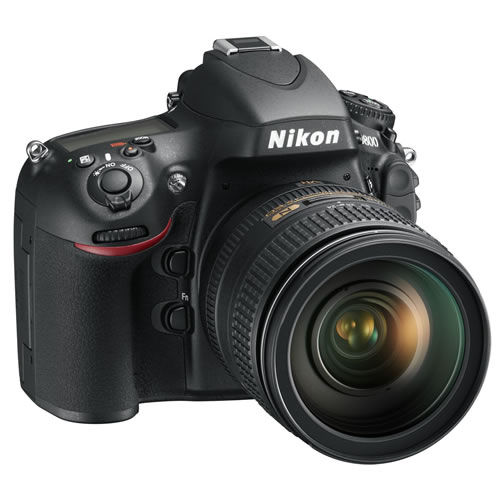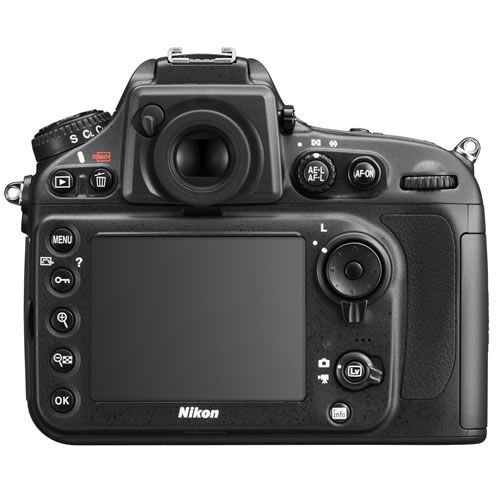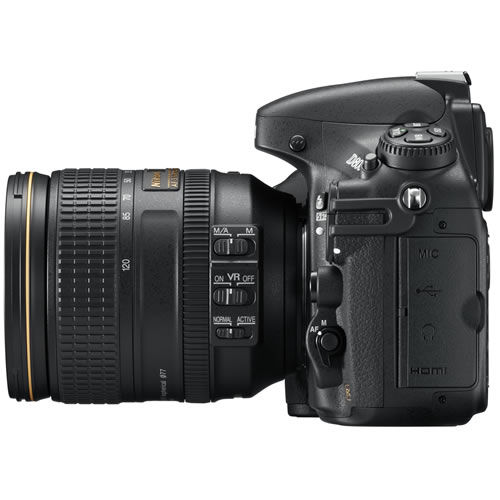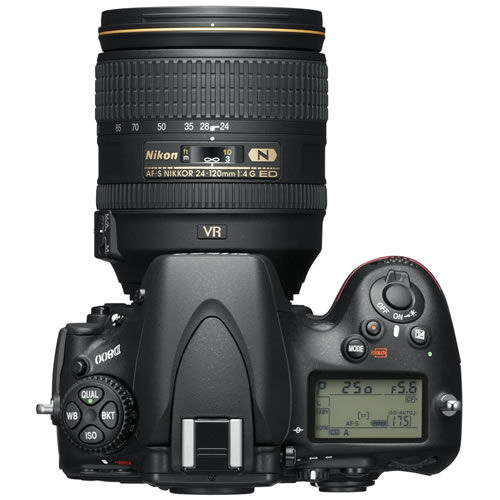- Rental ID: R304436
Rental Details
- Kit includes a Nikon D800 camera body, AF-s 24-70mm f2.8 ED lens, AF-s 70-200mm f2.8 VR II ED lens, 2 batteries, dual charger, and USB transfer cable.
Included in Rental
- 1 Nikon D800 Body
- 1 Nikon MH-25a Replacement Quick Charger for EN-EL15
- 1 TechCraft 3' USB 3.0 A to Micro-B Cable
- 1 Nikon AF-S 24-70mm f/2.8 G IF-ED Nikkor Zoom Lens
- 1 Nikon HB-40 Lens hood for AFS 24-70 mm f/2.8 Nikkor Zoom Lens
- 1 Nikon AF-S 70-200mm f/2.8G ED VR II Nikkor Telephoto Zoom Lens
- 1 Nikon HB-48 Replacement Lens Hood for AF-S 70-200 f2.8 G ED VRII
- 1 Nikon BF-1B Camera Body Cap
- 2 Nikon EN-EL15 Rechargeable Battery for D7100, D810, D610, D750
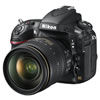
Nikon D800 w/afs 24-70 & 70-200 lens
$540.00/week Add to Request
Overview
Please Note: Attached lens not included.
Ultimate Image Quality. Full Cinematic Experience.
Hold in your hands an HD-SLR able to capture images rivaled only by those produced with a medium-format camera: extremely low noise, incredible dynamic range and the most faithful colours. Meet the Nikon D800, a 36.3 megapixel FX-format HD-SLR for professional photographers who require end results of the highest quality, who demand superior performance, speed, handling and a fully integrated imaging system. For cinematographers and multimedia professionals, 36.3 MP means true 1080p HD cinematic quality video and includes inputs for stereo microphones and headphones, peak audio meter display, DX crop mode to maximize NIKKOR lens selection and angle of view and much more.
Key Features
- 35.9 x 24.0mm CMOS FX Format Sensor
- 36.3 MP Resolution
- EXPEED 3 Image-Processing Engine
- 3.2" LCD Monitor
- Nikon F Mount Lens Mount
- Optical Low-Pass Filter
- Eye-Level Pentaprism Viewfinder
- 1920 x 1080/30/25/24p HD Video Capture
- Built-In Flash + i-TTL Flash Control
- Matrix/Centre-Weighted/Spot Metering
Nikon FX-Format CMOS Sensor with 36.3 Effective Megapixels
The D800 renders levels of texture, nuance and detail to your photography that, until now, have been the exclusive domain of the complicated medium-format system. Define every eyelash, every line in tree bark, and every shimmer of light. Savor the exceptional depth in your still images - with the astounding 36.3 effective megapixels, you can. Enlarge them as big as A1 poster-sized prints (23.4 x 33.1" /59.4 x 84.1cm) at 200 dpi, or crop aggressively to reach the composition you desire, all without sacrificing the detail and tonal range of the original. In order to maintain clean, high-resolution images, 14-bit A/D conversion within the sensor and a high signal-to-noise ratio deliver phenomenal images in a diverse array of situations. The image sensor's incredible potential does not stop with photography, either. For cinematographers ready to put their exceptionally sharp NIKKOR lenses into action, the D800's 36.3 effective megapixel data is efficiently processed for exquisite 1080p broadcast quality video at 30p.
Standard ISO 100 to ISO 6400 Expandable to ISO 50 to 25,600 Equivalent
High-resolution, studio-quality images shouldn't be restricted to the studio. The D800 sets a new benchmark for high resolution D-SLR cameras, with crisp clean images across a wide ISO range. Flexibility like this opens up new imaging opportunities for both still photographers and cinematographers alike during the "magic hour", the time just before dawn or at dusk when available light is often beautiful but scarce. Even at high ISO settings, the camera's intelligent noise reduction systems manage noise without sacrificing fine details, giving the D800 the edge. The difference can even be seen in low-contrast subjects such as hair and grass textures, which are often essential elements of cinema as well as high-resolution portraits and landscape images. High image quality at higher ISOs also means that you can shoot still images handheld more confidently, knowing that fast shutter speeds will reduce blur.
A Strategic Approach to Turn Light to Your Advantage
Combining both high-resolution performance and a wide ISO sensitivity range has finally become a reality. Nikon engineers have developed intelligent new methods to manipulate light transmission to the sensor's photodiodes: from the optical low-pass filter and on-chip gapless micro lenses to the image sensor's internal design, every measure has been taken to maximize and improve light transmission in order to deliver crisp, brilliant images with significantly less noise. All this is possible under a wide variety of lighting conditions, enabling you to get the most out of your NIKKOR lenses.
Optical Low-Pass Filter Optimized for Sharpness
Reducing false colour and moire is the main job of the optical low-pass filter located in front of the image sensor. However, this benefit is generally gained with a small sacrifice of sharpness. Moire occurs in scenes containing repetitive details, such as strong vertical lines in architecture. Finding the right balance between benefits and sacrifices is the key to higher image quality, and that is what the D800's optical low-pass filter delivers. As a result, the astounding 36.3 megapixels unleash their potential through an optimized balance between sharpness and effectively prevented moiré and false colour. Furthermore, the multi-layer structure of the D800 low-pass filter utilizes layers of antireflective coating that have been optimized for the camera, contributing to sharper and clearer images.
EXPEED 3 Image Processing Engine: Speed, Versatility, and High Performance
High-megapixel still images are detail-rich but data-heavy. With the D800, however, you don't have to sacrifice speed for this privilege. Dedicated to understanding speed and its role in image making, Nikon engineers designed a powerful EXPEED 3 image-processing engine exclusively for digital SLRs. From image processing and card recording to image playback and image transfer, EXPEED 3 manages massive amounts of data at faster speeds than EXPEED 2. Even with specialized processing features like Active D-Lighting and high ISO noise reduction, capture speed is not affected. EXPEED 3 is so powerful that it handles data-intensive tasks such as Full HD video recording at 30p with ease. You'll also notice the difference in your still images and videos through minimized noise and even richer colours and tones. In addition to these fundamental advantages, the D800 reduces the kind of colour phase shift that some cameras have difficulty with in similar situations.
Lateral Chromatic Aberration Reduction: Take Full Advantage of your NIKKOR Lens Collection
High-megapixel sensors can really test the quality of your lenses, but you can be confident that the combination of brilliant NIKKOR lenses and Nikon's intelligent processing measures will significantly reduce lateral chromatic aberration to give you incredibly natural-looking results. Unlike other correction methods that simply eliminate chromatic aberration, Nikon's method compensates for these colour differences in a resolving index for each colour, making it particularly effective in producing images with stunning edge-to- edge sharpness. Moreover, because these corrections are made regardless of the NIKKOR lens used, this feature contributes substantially to achieving the sharpest images possible.
14-bit A/D Conversion and 16-bit Image Processing for Rich Tones and Natural Colours
Tonal gradation is where an image transforms from simply representing life to taking on a life of its own. The D800 does exactly that, with cutting-edge image processing that injects vital energy into your images. Black is rendered as pitch black, and shadow details are subtle and rich. Even under harsh, high-contrast light, where some cameras can fail, the D800's gradation remains smooth with abundant detail and tone all the way up the scale to pure white.
Advanced Scene Recognition System with 91K-Pixel RGB Sensor
Nikon's revolutionary Advanced Scene Recognition System, introduced with the flagship D4 camera, is also employed in the D800. At its core is a 91K-pixel RGB sensor that meticulously analyzes each scene with the fine resolution. The RGB sensor can recognize your scene's colours and brightness with unprecedented precision, then use that information to implement various automatic controls and give you more natural-looking results. The real breakthrough, however, is that the sensor can detect human faces with startling accuracy when shooting through the optical viewfinder. Along with face detection, detailed scene analysis is utilized to support more accurate autofocus, auto exposure and i-TTL flash exposure results in a diverse range of compositional and lighting situations. The improved subject tracking is most noticeable when using 3D-tracking, which can maintain a focus on moving subjects smaller in size than with previous generations.
More Accurate Face Detection in Auto-Area AF and Subject Tracking in 3D-Tracking
Auto-area AF and 3D-tracking are AF-area modes unique to Nikon that use your subject's colour and brightness information to detect focus. With the D800 and its more precise information and subject recognition advancements, expect big steps forward for both AF-area modes when taking high-quality still images. In auto-area AF, the camera can genuinely detect human faces and focuses on them immediately - useful when faces are a priority and there's no time to choose focus points. When using 3D-tracking, the sensor's fine resolution combines with a specifically optimized AF algorithm to realize unprecedented subject tracking precision, recognizing detailed patterns to keep your subject in sharp focus.
3D Colour Matrix Metering III for More Accurate Exposures
Professional photographers who shoot still images know that Nikon's metering system delivers supremely well-balanced exposures. Thanks to the 91K-pixel RGB sensor, the D800 has far more detailed scene information at its disposal - including detected face information. This data helps the 3D colour matrix metering III deliver more desirable auto exposures, especially when there are human faces present. When the D800 recognizes a human face in a backlit situation, the camera determines the overall exposure while prioritizing the facial exposure, which might otherwise be underexposed. When a face is lit from the front and appears much brighter than the background, the camera recognizes the situation and avoids blowing out the facial details.
More Balanced Results in i-TTL Balanced Fill-Flash and Active D-Lighting
Nikon's i-TTL system has long been considered the most accurate flash control system in photography, but now face detection and highlight analysis by the 91K-pixel RGB sensor pushes performance even further. With the D800's enhanced i-TTL balanced fill-flash, you can more precisely illuminate people's faces in relation to their surrounding brightness using either the built-in flash or an external hot-shoed Nikon Speedlight. For weddings and fashion shoots, or any photography that relies on the highest-quality still images, this new standard redefines what a flash system should be. Face detection also makes a difference when Active D-Lighting is used to retain highlights and shadows in high-contrast lighting situations. Faces will be optimally exposed both in the sun and in the shade.
Light Source Identification for Auto White Balance in Still Images
The D800's auto white balance is incredibly accurate in a diverse range of shooting situations, aided by unique Nikon technology that effectively identifies your light sources, both natural and artificial. With the 91K-pixel RGB sensor and the image sensor working together, the camera renders white as white with supreme accuracy. Or if you prefer, the auto white balance can be set to reflect the warmth of ambient, incandescent lighting.
Advanced Multi-CAM 3500FX Autofocus Sensor Module for Razor-Sharp Detection in Low-Light
Accurate AF detection is crucial for extremely high-resolution still images in every situation. The 51 sensor points in the D800's AF sensor module work down to -2 EV (ISO 100, 68°F/20°C), the approximate physical limit of human visibility through an optical viewfinder. For even more powerful detection, you can rely on the camera's 15 crosstype sensors in the centre to detect both vertical and horizontal lines when using any AF NIKKOR lenses of f/5.6 or faster. What's more, AF can be activated with eleven focus points in the centre with open aperture of f/8, which is a big plus when you combine a telephoto lens with a 2.0x teleconverter to shoot distant subjects.
Versatile AF-Area Modes
Whether it's a still life, a portrait, a landscape or a candid street scene, your subject matter varies, but its importance doesn't. That's why the D800 offers four AF-area modes, each specifically tailored to adapt to various subjects. Single point AF is ideal when you need pinpoint focus on stationary subjects. Dynamic-area AF has three options (9-point, 21-point and 51-point) and is ideal for shooting moving subjects. The selected AF point and the surrounding points keep your subject in sharp focus even if it briefly leaves the selected points. 3D-tracking allows you to maintain focus on subjects that are moving erratically from side to side. Auto area AF detects human faces and prioritizes their sharpness for you - an ideal choice for candid photography.
36MP & D-Movie Broadcast Quality Video in Two D-Movie Formats: True Cinematic Experience
Full HD video quality and minimized rolling shutter effect: Dynamic movie shooting in diverse lighting situations
Many filmmakers, multimedia professionals and still photographers need the highly mobile, lightweight and compact form of a D-SLR in order to cover large events or make documentaries, music videos or movies. For these professionals, the D800 is ready to create true cinematic experiences. By using the B frame data compression method, you can record 1080p Full HD video at 30p in H.264/MPEG-4 AVC format with unmatched moving image integrity for up to 29 min. 59 seconds of recording in a single clip. Thanks to Nikon's latest image-processing optimizations, the monumental power of 36.3 megapixels transforms to sharp, exquisitely rendered videos. Expect exceptionally smooth gradation in blue skies, with minimum block noise and beautifully natural movement rendered clearly and sharply. The D800's intelligent image sensor reads out movie images at faster rates than ever, significantly reducing the rolling shutter distortion that can occur during panning shots or when shooting fast-moving lateral subjects like trains. Thanks to EXPEED 3, your movies will take on a distinctive look of their own, even with dimly lit scenes. Combine these benefits and you'll begin to realize exactly the new creative opportunities possible for photographers and cinematographers alike.
Multi-area mode full HD D-Movie: Creative movie-making freedom in FX and DX based formats
The D800 is designed to stimulate cinematographers to explore different moods and perspectives by enabling Full HD and HD video recording in two frame formats; Nikon FX- and DX-based movie formats in just one camera. When using wide-aperture NIKKOR lenses, the large image area of the FX-based format renders exquisitely shallow depth of field with beautiful bokeh effects. The DX-based format uses an image area similar to 35mm movie film, allowing cinematographers to shoot with picture angles that they are accustomed to. Having the advantage of two D-Movie formats in one camera and an arsenal of NIKKOR lenses makes the D800 an incredibly versatile movie-making tool.
Smoother video recording under fluorescent or mercury lamps: Auto flicker reduction
With the D800, it is easier than ever to reduce flicker effects during live view and video recording. Simply use auto in the flicker reduction menu to automatically identify the flicker frequency at the beginning of live view and switch to the one that will work best. You can also manually switch between 50 Hz and 60 Hz.
Integrated Operation
Live view selector for optimized still images and movies
The D800's live view operation has evolved even further, optimizing camera control to become more intuitive for shooting video as well as still images. Simply clicking the live view selector switches between live view modes designed specifically for still images or movies. Live view photography lets you shoot still images while confirming the exposure level on the LCD monitor. You can even magnify images up to approx. 23x to check the exact focus. For movie live view on the other hand, the D800 incorporates a dedicated exposure control for quality video shooting, enabling smooth exposure transition when shooting moving subjects. You can also shoot video with full manual control. When needed, press the shutter-release button while filming to instantly capture still images in 16:9 aspect ratio. Each time you use live view, for either still photography or movie shooting, your image area and camera setting information will be clearly indicated, allowing you to confirm quickly.
View simultaneous live view output on external monitors and record uncompressed video via HDMI
During movie shooting, you can now simultaneously check videos on an external monitor using an HDMI connection, in addition to the camera's TFT monitor. And for those who need the purest video output for professional quality editing, you can now record uncompressed movie live view footage directly to an external storage device via HDMI interface.
Comprehensive high-fidelity audio recording control
The D800 is designed for crisp stereo recording with a built-in external stereo microphone input. Attach the compact ME-1 Stereo Microphone to record clear sound while significantly reducing mechanical noise. An external headphone jack enables you to effectively monitor and control audio in isolation. While the audio level indicators offer visual confirmation of audio level, the microphone sensitivity can be controlled precisely in 20 incremental steps.
Time-lapse photography
Capture a variety of scenes and subjects at a breathtaking pace. The D800's time-lapse photography lets you set intervals and frame rates in order to dramatically relay slow moving activity at dramatic speeds. The D800 allows you to shoot time-lapse photography with replaying rates from 24 times to 36,000 times faster than normal. Time-lapse photography files can be saved as a movie file.
Versatile custom settings for D-Movie
The D800 has addressed useful feedback from videographers with convenient custom controls for D-Movie operation. Instead of rotating the command dial, power aperture enables smoother aperture controls during movie live view using a button designated via custom menu, which can be very convenient to confirm depth of field. Index marking helps you locate important frames for later-stage in-camera editing and replay by attaching markers during movie recording. Markings are indicated along with the timeline, which is easy to confirm visually.
Vision You Can Depend On
Glass prism optical viewfinder with approximately 100% frame coverage
See every important element in your frame clearly and precisely. The D800 offers approx. 100% frame coverage (in FX format) from its slim pentaprism, giving you the visually comfortable FX-format advantage and an unobstructed view when shooting still images. The viewfinder image is not only large and bright - the focusing screen is also carefully designed to help you sense sharp focus intuitively, be it manual or autofocus.
Precision 3.2" (8cm), 921k-dot, wide-viewing-angle LCD monitor with automatic monitor brightness control
The D800's large and sharp colour LCD monitor delivers bright, crisp image playback with a much larger capacity for accurate colour reproduction. Using an antireflective structure, you can count on clarity equal to that of the D4, even under bright conditions. Moreover, if monitor brightness is set to "Auto", the camera automatically adjusts LCD brightness according to the environmental lighting conditions measured by the ambient brightness sensor, allowing easy use of live view in both bright and low-lit places - very useful when shooting video and stills. The ability to magnify playback images up to 46x (Large-size images in FX format) is extremely helpful for spot focus confirmation.
Ready for Demanding Tasks
Lightweight yet durable construction
Many important parts of the D800 have been designed to achieve better durability and lighter weight. The result is a camera approx. 10% lighter than the D700, yet just as rugged. A magnesium alloy construction protects the sophisticated technologies against accidental shock, and weather and dust sealing has been extensively applied and severely tested, making the D800 as reliable on the road as it is in the studio.
Fast response time
The D800 is designed to respond immediately. Once the strategically located switch is turned on, the camera starts up in approx. 0.12 seconds and your finger is in position for shutter release. Release time lag is minimized to approx. 0.042 seconds, equivalent to that of the D3S, with continuous approx. 4 fps capability in FX format, approx. 5 fps in 1.2x and DX format and 6 fps capability in DX format with MB-D12.
High-precision sequential control mechanism
For true digital SLR excellence, the camera's mechanical structure, power and precision are vital to ensure indispensable speed and reliability. That's why Nikon utilized its engineering expertise to refine the powerful sequential control mechanism that drives the shutter, mirror, and aperture independently. As a result, shutter release can be operated with mirror-up position during live view. Because mirror-down movement is not required, you can expect even quieter still live view shooting. And as power aperture control operates via the stepping motor, the sound of mechanical adjustment is reduced for quieter and smoother control.
High-speed CF and SD dual card slots
Card recording speed is yet another crucial element of a smooth and productive shooting experience. The D800 CF memory card slot is compatible with the latest UDMA 7. The SD card slot is compatible with SDXC (Secure Digital eXtended Capacity) and UHS-I. You can also use two cards simultaneously for a number of functions, such as recording JPEG and RAW data on separate cards, recording the same data simultaneously on two cards for backup and more.
High-speed data transfer with USB 3.0
For a more productive tethered and transfer workflow, the D800 is compatible with USB 3.0. When connected to equipment featuring USB 2.0, speed is reduced to that of USB 2.0.
High-precision, high-durability shutter
The D800's shutter unit has been tested to well over 200,000 cycles of release to prove durability and precision. While the shutter unit designed to run at a speed range of 1/8,000 to 30 seconds, its intelligent self-diagnostic shutter monitor automatically monitors actual shutter speeds in order to correct possible variances that can occur over time.
Efficient power management
A comprehensive re-working of the D800's circuits now enables approximately 900 shots of still image shooting. All on one charge of an EN-EL15 rechargeable lithium-ion battery.
MB-D12 multi-power battery pack (optional)
Attach the MB-D12 to the camera body to extend battery stamina. The pack accommodates a variety of batteries (see specifications) and utilizes the same integral magnesium alloy construction and weather sealing as the D800 body itself. You also get approximately 6 fps continuous shooting speed in DX format. The MB-D12 has its own dedicated shutter-release button and command dials for vertical composition shooting.
Connecting Hands, Eyes, and Ideas
Improvements around the shutter-release button
Angle, shape, contour, and texture: all of these design facets came into play when crafting the D800's shutter-release button. Your index finger can rest comfortably for longer periods of time, allowing you to concentrate when it matters, while the designated movie-record button means you're ready to trigger movie shooting in an instant.
Direct access to Picture Control
Customize the look of your stills and videos through Picture Controls by fine-tuning parameters such as sharpening, saturation, and hue. The D800 now allows you to access Picture Control instantly and directly from a dedicated button rather than entering the menu. When live view shooting, you can visually confirm how customized Picture Control settings will look and easily adjust the parameters.
Choosing AF mode and AF-area mode combinations
Control your desired AF mode (continuous or single servo) and AF-area mode (single-point, dynamic area, 3D-tracking or auto area AF) without ever taking your eye away from the viewfinder. By using a dedicated AF-mode button and command dials, you can switch between modes without interrupting your creative flow.
Four-button layout and release mode dial on the camera's top deck
Important camera settings can be controlled and adjusted from buttons placed on the top deck. Along with dedicated buttons for ISO, white balance and image quality, a new bracketing button has been strategically placed to aid such features as HDR. In addition, the release mode dial also improves mode visibility and operability.
Creative Expansion Tools
Expand dynamic range: HDR (High Dynamic Range)
The D800 can shoot two frames in a single shutter release, but at different exposures: one overexposed and one underexposed. The camera then instantly combines them to create an image covering a wider dynamic range. The range can be widened by up to 3 EV for different looks, all full of saturation and tonal gradation, while the smoothness of the edge where the two exposures meet can be adjusted for a more natural appearance.
Shoot achieving reduced blur with zoom lenses in dim light: Auto shutter speed control for auto ISO sensitivity control
The D800 comes equipped with an auto option for minimum shutter speed that automatically controls the balance between shutter speed and the ISO sensitivity based on the focal length of the lens being used. This can be particularly useful when using a zoom lens, because the camera can automatically choose the shutter speed to reduce camera shake. What's more, through the operation of ISO button and sub-command dial, auto ISO sensitivity control can be immediately turned on or off, without needing to enter the menu.
Accurate confirmation of level shooting: Dual-axis electronic virtual horizon
With the D800, you can always check the LCD monitor or the viewfinder for both the camera's position in relation to the horizontal plane and its pitch (forward or rear rotation). This can enhance compositional accuracy, particularly when shooting still life, landscapes, and architecture.
Shoot with multiple formats in one camera: Image area options
The D800 offers four image area options: FX format (35.9 x 24.0mm), 5:4 (30.0 x 24.0mm), 1.2x (30.0 x 19.9mm), and DX format (23.4 x 15.6mm) with all cropped image areas visually masked in the viewfinder. DX format offers approx. 1.5x, and 1.2x crop offers approx.1.2x telephoto effect. When a DX NIKKOR lens is used, DX format is automatically selected.
Refined colour temperature control: Minute control over white balance
The D800's white balance proves its reliability even when using an external flash and live view in the studio environment. The monitor hue of live view and resulting image's white balance can be individually set so that the difference between the two is minimized. Furthermore, for even more control, colour temperature can be manually set in 10-kelvin increments or in mired units.
Image enhancement options: In-camera editing
Captured images and movies can be altered and edited in-camera and on the fly if required, all without the need to resort to a computer. Retouch menus include an array of useful features such as NEF (RAW) processing, resize, distortion control, fisheye, miniature effect, red-eye correction, filter effects and image overlay, as well as the ability to designate the start and end point of movie clips all at once, in order to save them more efficiently.
Nikon Software
Capture NX 2 (Optional): Optimal for processing images taken with the D800
To accommodate the imaging power of the D800's 36.3 effective megapixels, the latest Capture NX 2 now features powerful 64-bit processing. Capture NX 2 drastically simplifies an array of image enhancement procedures, letting you concentrate on making your pictures the best they can be. Instead of complicated layering and memorization, simply place a colour Control Point wherever you want to reprocess. colour Control Points use intuitive slider controls to make quick and easy adjustments to image characteristics such as brightness, contrast, saturation and tones. Change, adjust and experiment all you like, safe in the knowledge that all changes are nondestructive and an original always remains intact.
ViewNX 2: Browse, edit, share, and more
This bundled, all-in-one software implements an easy-to-use interface for all your photos and movies. Take advantage of an array of editing functions, including basic editing of RAW files and even D-Movies. ViewNX 2 also works effortlessly with Nikon's photo-sharing and storage service, my Picturetown, with labels to help you find that special photo quickly and easily.
Camera Control Pro 2 (optional): Extremely versatile remove camera controls
For those that want to operate their camera via computer, Camera Control Pro 2 lets you control camera settings and various features from a distance. Aside from controlling exposure mode, shutter speed, and aperture, the software now offers numerous improvements to make the D800's live view operation exceptionally smooth. Creative control opportunities include remote start and stop for movie shooting and switching between live view for stills and movies. You can also adjust the monitor hue of live view photography and the resulting image's white balance individually, which can be quite helpful when working in the studio. You can also display audio level indicators during movie shooting. And with the optional Wireless Transmitter WT-4A/B/C/D/E, image files can be transferred using either Wi-Fi or an Ethernet connection.
What's Included
- Nikon D800 Body
- AN-DC6 Strap
- EN-EL15 Rechargeable Li-ion Battery
- MH-25 Battery Charger
- UC-E14 USB Cable
- BM-12 LCD Monitor Cover
- BF-1B Body Cap
- BS-1 Accessory Shoe Cap
- DK-17 Viewfinder Eyepiece
- NikonView NX2 CD ROM
- Limited Warranty
Product Specifications
| Detailed Specifications | |
|---|---|
| Lens Mount | Nikon F bayonet mount |
| Effective Pixels | 36.3 million |
| Sensor Size | 35.9mm x 24mm |
| Image Sensor Format | FX |
| Image Sensor Type | CMOS |
| Total Pixels | 36.8 million |
| Dust-reduction system | Image sensor cleaning |
| Dust-Off Reference Photo | Yes |
| Image Area (pixels) | FX-format (L) 7,360 x 4,912, (M) 5,520 x 3,680, (S) 3,680 x 2,456 1:2 format (30 x 20) (L) 6,144 x 4,080, (M) 4,608 x 3,056, (S) 3,072 x 2,040 5:4 format (30 x 24) (L) 6,144 x 4,912, (M) 4,608 x 3,680, (S) 3,072 x 2,456 DX-format (L) 4,800 x 3,200, (M) 3,600 x 2,400, (S) 2,400 x 1,600 |
| File Format Still Images | JPEG: JPEG-Baseline compliant with fine (approx 1:4), normal (approx 1:8), or basic (approx 1:16) compression NEF (RAW): lossless compressed 12 or 14 bit, lossless compressed, compressed or uncompressed TIFF (RGB) JPEG: JPEG-baseline-compliant; can be selected from Size Priority and Optimal Quality |
| Picture Control | Landscape, Monochrome Neutral, Portrait, Standard, User-customizable Settings, Vivid |
| Storage Media | CompactFlash© (CF) (Type I, compliant with UDMA) SD SDHC SDXC |
| Card Slot | 1 CompactFlash© (CF) card and 1 Secure Digital (SD) card |
| File System | Compliant with DCF (Design Rule for Camera File System) 2.0 DPOF (Digital Print Order Format) EXIF 2.3 (Exchangeable Image File Format for Digital Still Cameras PictBridge |
| Viewfinder | Eye-level pentamirror single-lens reflex viewfinder |
| Viewfinder Frame Coverage | FX (36x24): 100% Horizontal and 100% Vertical Approx. 1.2x (30x20): 97% Horizontal and 97% Vertical Approx. DX (24x16): 97% Horizontal and 97% Vertical Approx. 5:4 (30x24): 97% Horizontal and 97% Vertical Approx. |
| Viewfinder Magnification | 0.70x Approx. |
| Viewfinder Eyepoint |
19.5 (-1.0m-¹)
|
| Viewfinder Diopter Adjustment |
Built-in diopter adjustment (-3 to +1 m-¹)
|
| Focusing Screen | Type B BriteView Clear Matte Mark VIII with AF area brackets (grid lines can be displayed) |
| Reflex Mirror | Quick-return type |
| Lens Aperture | Instant-return type |
| Depth-of-field Control | Yes |
| Lens Compatibility at a Glance*** | AF-S or AF lenses fully compatible Metering with AI lenses |
| Compatible Lenses | AF NIKKOR other than type G or D: All functions supported except 3D Colour Matrix Metering III AI-P NIKKOR: All functions supported except autofocus and 3D Colour Matrix Metering III DX AF NIKKOR: All functions supported except FX-format (36x24)/5:4 (30x24) image size Non-CPU: Usable in [A] or [M] mode Centre-Weighted or Spot Metering; Electronic Rangefinder usable with lens with maximum aperture of f/5.6 or faster Type G or D AF NIKKOR: All functions supported |
| Shutter type | Electronically controlled vertical-travel focal-plane |
| Shutter Speed | 1/8000 to 30 sec. Bulb |
| Flash Sync Speed |
Up to 1/250 sec.
Synchronizes with shutter at 1/320s or slower (flash range drops at speeds between 1/250 and 1/320s) |
| Shutter Release Modes | Continuous low-speed [CL] mode; 1-4 frames per second Continuous high-speed [CH] mode; 4 frames per second Mirror-up [Mup] mode Quiet Shutter Release Self-timer mode Single-frame [S] mode |
| Continuous Shooting Options | FX-format CH: Up to 4 frames per second, CL: Up to 4 frames per second 5:4 format CH: Up to 4 frames per second, CL: Up to 4 frames per second DX-format CH: Up to 5 frames per second, CL: Up to 5 frames per second 1:2 format CH: Up to 5 frames per second, CL: Up to 5 frames per second |
| Top Continuous Shooting Speed at full resolution | 4 frames per second |
| Self-timer | 2, 5, 10, 20 sec. Timer duration electronically controlled |
| Exposure Metering System | TTL exposure metering using 91,000-pixel RGB sensor |
| Metering Method | Centre-weighted: Weight of 75% given to 8mm circle in centre of frame Matrix: 3D colour matrix metering III (type G and D lenses); colour matrix metering III (other CPU lenses) Spot: Meters 4mm circle (about 1.5% of frame) centered on selected focus point |
| Metering Range | 0 to 20 EV (3D colour matrix or centre-weighted metering) 0 to 20 EV (spot metering) |
| Exposure Meter Coupling | CPU AI |
| Exposure Modes | Aperture-Priority (A) Manual (M) Programmed auto with flexible program (P) Shutter-Priority (S) |
| Exposure Compensation | ±5 EV in increments of 1/3, 1/2 or 1 EV |
| Exposure Bracketing | 2 to 9 frames in steps of 1/3, 1/2, 2/3 or 1 EV |
| Exposure Lock | Yes |
| Mirror Lock Up | Yes |
| ISO Sensitivity | ISO 100 - 6400 Lo-1 (ISO 50) Hi-1 (ISO 12,800) Hi-2 (ISO 25,600) |
| Long Exposure Noise Reduction | Yes |
| High ISO Noise Reduction | Low, Normal, High, Off |
| Active D-Lighting | Auto, Extra High, High, Normal, Low, Off |
| D-Lighting Bracketing | 2 frames using selected value for one frame 3–5 frames using preset values for all frames |
| Single-point AF Mode | Yes |
| Dynamic AF Mode | Number of AF points: 9, 21, 51 and 51 (3D-tracking) |
| Auto-area AF Mode | Yes |
| Autofocus System | Nikon Advanced Multi-CAM 3500FX autofocus sensor module with TTL phase detection |
| Detection Range | -1 to 19 EV (ISO 100, 68°F/20°C) |
| Lens Servo | Autofocus (AF): Single-servo AF (AF-S); continuous-servo AF (AF-C); auto AF-S/AF-C selection (AF-A); predictive focus tracking activated automatically according to subject status Manual focus (MF): Electronic rangefinder can be used |
| AF-area mode | 9, 21 or 51 point Dynamic-area AF Auto-area AF Single-point AF 3D-tracking (51 points) |
| Focus Lock | Focus can be locked by pressing AE-L/AF-L button Focus can be locked by pressing shutter-release button halfway (single-servo AF) |
| Focus Modes | Auto AF-S/AF-C selection (AF-A) Continuous-servo (AF-C) Face-Priority AF available in Live View only and D-Movie only Full-time Servo (AF-A) available in Live View only Manual (M) with electronic rangefinder Normal area Single-servo AF (AF-S) Wide area |
| Maximum Autofocus Areas/Points | 51 |
| Autofocus Sensitivity | -2 to +19 EV (ISO 100, 20°C/68°F) |
| Autofocus Fine Tune | Yes |
| Built-in Flash | Yes |
| Flash Bracketing | 2 to 9 frames in steps of 1/3, 1/2, 2/3, or 1 EV |
| Built-in Flash Distance | 39 ft. (ISO 100) |
| X-Sync Speed | 1/250 |
| Top FP High Speed Sync | Up to 1/8000 |
| Flash Control | TTL: i-TTL flash control using 91,000-pixel RGB sensor are available with built-in flash and SB-910, SB-900, SB-700, or SB-400; i-TTL balanced fill-flash for digital SLR is used with matrix and center-weighting metering, standard i-TTL flash for digital SLR with spot metering |
| Flash Sync Modes | Front-curtain sync (normal) Rear-curtain sync Red-eye reduction Red-eye reduction with slow sync Slow sync |
| Flash Compensation | -3 to +1 EV in increments of 1/3, 1/2 or 1 EV |
| Flash-ready indicator | Lights when built-in flash or optional flash unit such as SB-910, SB-900, SB-400, SB-80DX, SB-28DX or SB-50DX is fully charged |
| Accessory Shoe | Yes |
| Nikon Creative Lighting System (CLS) | CLS Supported |
| Flash Sync Terminal | Yes |
| White Balance | Auto (2 types), Choose colour temperature (2500K–10000K), Cloudy, Direct Sunlight, Flash, Fluorescent (7 types), Incandescent, Preset manual (up to 4 values can be stored), Shade |
| White Balance Bracketing | 2 to 9 exposures in increments of 1, 2 or 3 EV |
| Live View Shooting | Photography Live View Mode Movie Live View Mode |
| Live View Lens Servo | Autofocus (AF): Single-servo AF (AF-S); full-time-servo AF (AF-F) Manual focus (MF) |
| Live View AF-Area Mode | Face-priority AF Wide-area AF Normal-area AF Subject-tracking AF |
| Live View Autofocus | Contrast-detect AF anywhere in frame (camera selects focus point automatically when face-priority AF or subejct-tracking AF is selected |
| Movie Metering | TTL exposure metering using main image sensor |
| Movie Frame size (pixels) and frame rate | 1280 x 720 (30p): 30 fps (29.97 fps) 1280 x 720 (60p): 60 fps (59.94 fps) 1920 x 1080 (24p): 24 fps (23.976 fps) 1920 x 1080 (30p): 30 fps (29.97 fps) |
| Movie Maximum recording time | 20 minutes at highest quality 29 minutes 59 seconds at normal quality |
| Movie File Format | MOV |
| Movie Video Compression | H.264/MPEG-4 Advanced Video Coding |
| Movie Audio recording format | Linear PCM |
| Movie | HD 1,920x1,080 / 30 fps HD 1,920×1,080 / 24 fps HD 1,280×720 / 30 fps HD 1,280×720 / 24 fps HD 1,280x720 / 60 fps |
| Movie Audio | Built-in microphone, monaural External stereo microphone (optional) |
| Monitor Size | 3.2 in. diagonal |
| Monitor Resolution | 921,000 Dots |
| Monitor Type | Wide Viewing Angle TFT-LCD |
| Monitor Angle of View | 170-degree wide-viewing angle |
| Monitor Adjustments | Brightness, 5 levels |
| Virtual Horizon Camera Indicator | Yes Also visible in LiveView Modes Also visible in Viewfinder |
| Playback Functions | Auto Iimage Rotation, Full-Frame and Thumbnail (4, 9, or 72 images or calendar), Histogram Display, Image Comment, Movie Playback, Movie Slideshow, playback with Zoom, Slideshow, Highlights |
| In-Camera Image Editing | Colour Outline, Colour Sketch, D-Lighting, Distortion Control, Edit Movie, Filter Effects, Fisheye, Image Overlay, Miniature Effect, Monochrome, NEF (RAW) Processing, Perspective Control, Quick retouch, Red-eye Correction, Resize, Selective Colour, Side-by-Side Comparison, Straighten, Trim, Colour Balance |
| Image Comment | Yes |
| Interface | HDMI Output: Type C mini-pin HDMI connector Headphone Connector NTSC Stereo Microphone Input Super Speed USB 3.0 |
| Wi-Fi Functionality | Eye-Fi Compatible WT-4A |
| GPS | GP-1 GPS unit |
| Save/Load Camera settings | Yes |
| Total custom Settings | 54 |
| My Menu | Yes with customization |
| Recent Settings | Yes |
| Supported Languages | Arabic, Chinese (Simplified and Traditional), Czech, Danish, Dutch, English, Finnish, French, German, Indonesian, Italian, Japanese, Korean, Norweigan, Polish, Portuguese, Romanian, Russian, Spanish, Swedish, Thai, Turkish, Ukrainian |
| Date, Time and Daylight Savings Time Settings | Yes |
| World Time Setting | Yes |
| Battery / Batteries | EN-EL15 Lithium-ion Battery |
| Battery Life (shots per charge) | 900 Battery Life (shots per charge) (CIPA) |
| AC Adapter | EH-5b AC Adapter Requires EP-5B Power Supply Connector |
| Battery Charger | MH-25 Quick Charger |
| Tripod Socket | 1/4 in. (ISO 1222) |
| Operating Environment | 0–40 °C (+32–104 °F) |
| Approx. Dimensions | Width 5.7 in. (144.78mm) Height 4.8 in. (121.92mm) Depth 3.2 in. (81.28mm) |
| Approx. Weight | 31.7 oz. (900g) camera body only |


